
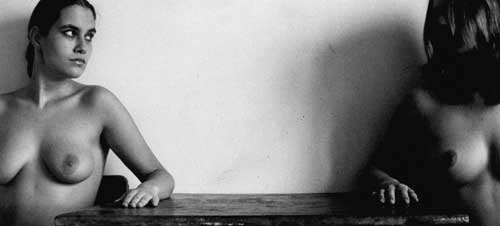
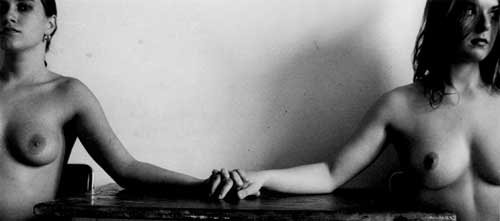
Polki-Polki, 2002
of "Poor Photography"
A Pinch of Theory
Reaching for various photos (I have in mind those which are published and exhibited) I have always been looking for the eúdos of photography, in other words, for its nature and fundamental being, which is changeable. What do we expect from photographs to get the feeling of the seed of death (Roland Barthes's punctum), to experience a hedonistic moment of pleasure (Man Ray) or to feel its morbid atmosphere (Susan Sontag)? Or perhaps all of the above, since the photography does not have any limits set once and for all, it is defined only by its own medium, and therefore changes all the time. Maybe we are also looking for a moment of reflection on the passing of time and transitory moments which are unique and in a certain way define the present, our status quo.
"The slit", "the crack" of being in photography, in spite of its ironic character, dressed in a feminist costume, is still significant. What is important is the authenticity, not the accidentality of being (Zygmunt Bauman), the search for and the acceptance of "the Other" (alien), which in farther perspective leads to the creation of new layers of culture. We must stress at this point that postmodern culture may also possess a spiritual and existential dimension. It does not have to be interpreted merely as the time of chaos and downfall. It is, at least partly, the development of lateral (rhizome) tendencies of modernism, starting from the beginning of the 20th century, but it functions in a different social and political system and most of all in a different system of information transfer which makes for the hierarchy in postmodern society. Postmodern art is also based on latest technologies, like modernism before it. What was once regarded as too drastic and aggressive towards the establishment on the fringes of the classic avant-garde has become to some extent the measure accepted within the limits of the liberal system which gradually adapts more and more difficult problems of moral nature (like homosexuality). Postmodern culture may give birth to art as long as its artistic problems can be elevated to a higher level of spiritual (existential) evolution and are not considered to be but signs and traces and as long as its ultimate aim concentrates around higher or to the highest values. But I am merely theorizing here...
How to change (combine!) one's identity?
In the 1990s and at the beginning of the 21st century neofeminism in Poland has become one of the dominating tendencies of our culture and has stimulated its changes. "Neofeminist art" is a new form of left-wing ideology fighting for a better world in the future. In Polish art after the expansive phase of "critical art" which to some extent expressed neofeminist ideas (exhibition entitled Antyciała [Antibodies]), aesthetic accents have moved in the direction of folk art (Grzęda [Roost] group from Cracow), or on the contrary, in the direction of intimate feminine art - intimate in the sense that it refers to such notions as home and maternity, but within the boundaries of a formula which relates to mass media and their "mythems" (Stefan Morawski's term). Contemporaray feminism is less radical, i.e. rebellious, but no less interesting. This aspect of contemporary cultural changes has been presented at an exhibition entitled Biały Mazur [The White Mazurka] (Bunkier Sztuki [Bunker of Art] in Cracow, 2004).
Does the art of the hueckelserafin duo concern the problem of postmodern culture or rather art within its old paradigm? Is it heterogenous in its artistic subject matter or on the contrary - concentrated around a single problem, defined by the requirements of neofeminism?
Their first series called Polki-Polki [Polish Women-Polish Women] and Zamiana II [Switch II] had to do with the desire to combine two separate beings and identities which used to be close to each other. Can such a transfomation be shown by means of a metaphorical switch of clothes? In my opinion, only partly. Magda Hueckel's and Agata Serafin's career started from feminism which concerns postmodern culture more than art (including photography) within its old paradigm. Today's neofeminism (or postfeminism) results from numerous avant-garde experiences. Playing with the audience, provoking them slightly, especially those viewers who are not used to nakedness, posing questions about the woman's status, playing games with viewers - those are only some aspects of the two aforementioned series. In the work called Polki-Polki the most important gesture is holding hands and looking into each other's eyes. It has to do not only with the discovering of one's own physique, but also personality. However, this work also has a different aspect - an even more important gesture here is the gesture of unification which might be called "a Virginia Woolf syndrome", presented in a subtle way - for example - in the movie "Hours" (directed by Stephen Daldry, USA, 2002). What is also significant is the irony contained in the title, referring to Polish women (Polki), and resulting from the Slovak meaning of this word.1 Most of the works in which the images of the two artists are presented reveal the narcisstic nature of the authoresses - just like potentially each look in the mirror is narcisstic. Even the first self-portrait in photographic history, shot in 1840 by Hypollite Bayard, is still interpreted in this way.
Zamiana II is the continuation of the previous series. It is a kind of a simple performance, a message which confirms the transformation that results from changing clothes. The first and the last work of the series is static, psychologism can be seen in the models' faces, while the four middle photographs are dynamic, blurred on purpose, and they make use of the incompleteness of the frame. Laughing faces contrast with the first and last work of the series. Zamiana II obviously has taken place as far as it was possible - it was a physical and most of all, a psychological switch. Such an interaction between the two friends had to take place - it is confirmed by their further works and series of works, and even by their common final exam realization called Aneks [Supplement, 2004], presented at the ASP [Academy of Fine Arts] in Gdańsk.
Zamiana III [Switch III, 2005] comes closer to Morfy [Morphs] since the blurry visual message presents regular, rhythmical and even systematic transformation of one face into the other.
Playing (?) with each other
Laleczki [Little Dolls] series was originally more extensive, employed too many motifs and in effect led not to the dispersal of meanings but to the presentation of too many visual suggestions about the body and its "decapitation". Moreover, it contained many works which were rather graphic in character. The series was shown in this form at Miesiąc Fotografii [Month of Photography] in Cracow in 2004. In 2005 at an exhibition in Sopot the number of works in the Laleczki series was reduced and the authoresses concentrated more on the problem of carnality. For example, they did not show a work presenting a parcel with their images, tied with a string, and works of multiplied images of "empty" clothes, devoid of bodies, which were rather conceptual in meaning.2 This series viewed from a formal perspective is most of all graphic - there is no background here, no reality, just bodies or their fragments and sometimes the shadows of fragments cut out from photographs.
The artists also successfully probed the problem which became very popular in the 1990s, which may be reduced to a campaign against the image of a beautiful body, promoted, for example, by mass media. This kind of art - but from a more perverse and expressionistic perspective - was pursued in the 1930s of the 20th century by a surrealist Hans Bellmer in his two series Lalki [Dolls]. So even at this time "a doll" was a synonym of different femininity it was a symbolic and horrible revelation of womanhood. Later other artists followed in Bellmer's footsteps: Orlan, who combined ideal beauty and plastic surgery on her own face, or a more conceptual Zbigniew Libera, who reffering to the idea of ready-mades created products-dolls contaminated by syndromes of various civilizational "diseases". Paradoxically, Orlan's body art and Libera's objects are quite similar in the ways they treat the commercial image of ideal beauty.
Models in the photographic cut-outs from the photographs of the hueckelserafin duo are devoid not only of clothes but also of various body parts. It turns out that playing, especially at certain times, can be reduced to the paradox of playing with each other - with one's own image or one's own body. In this way they impose the stereotypes of various initiations that might lead to the creation of a fetish of the woman-as-a-doll, unaware of the role she plays not in culture any more, but in commercialized society in which she becomes a kind of advertisement.
Life is a Cage
Within the Morfy series another extensive work has come into being - a realization called Klatka [Cage], containing eighteen photographs which vary as to the shades of whiteness, greyness and blackness. This series may be exhibited in various ways as far as the location of individual works is concerned.
It is the most theatrical realization of the hueckelserafin team in which by means of multiple exposition a "dissemination" of spirited personalities was achieved - the personalities of Magda and Agata. What is interesting in this series is phantasmagoria and transitoriness - in a word, immateriality, so rare and so difficult to grasp in art. The models seem alienated, they want to contact and understand each other. In other pictures they appear in the background of heavenly whiteness perfect in its immaculateness and still in others they are shown against a grey or an almost black background. The way out of this trap may be a door, conceived as a symbol of the road leading to another world, but the door is closed and inaccessible. The characters presented are immaterial and resemble their own doubles or ghosts more than real, physical figures.
Towards a synthetic portrait
Many painters and later photographers pursued the concept of the so-called synthetic portrait which was supposed to combine the physical aspect of being with the spirituality of the portraited person. The artistic attraction of Morfy may be attributed to the fact that this series shows the physical domination of Magda over Agata and vice versa, stressing at the same time - which is very important - different emotional states of the two artists. In other works they try to grasp the idea of the synthesis of two identical "halves", which was signalled earlier in the mini-series Polki-Polki.
The effect of those photographs is obviously symbolic and comes close to existential analysis but it also contains a postulate of virtuality which can be achieved by means of a synthetic, digital image. Such works were realized by an American artist Nancy Burson in the 1980s. The difference lies in the fact that the works of the hueckelserafin duo are made imperfect on purpose and that they fight against technical limitations, which is visible in the contours of their works. Magda and Agata continue, not in terms of programme, but in terms of ideology, the experiments of photosynthesis carried out by Krzysztof Pruszkowski in the 1980s and 90s of the 20th century. In the digital image there is no struggle against matter and the artist usually becomes a Pyrrhic winner, as in the case of Ryszard Horowitz, for example.
It is curious that the photos of the hueckelserafin duo do not represent a conventional portraiting style and that their background changes - from light through grey to black, which gives the photos a symbolic dimension. Another interesting element (employed quite consciously) is "the aesthetics of error", based on revealing particles of dust on the negative and the use of almost imperceptible manual manipulations that are supposed to remind us of traces of destruction or unclear danger. Therefore, those works are also meant to be viewed from a very close distance.
But a synthetic portrait which is perfect thanks to its simulation (simulacrum) is based most of all on synthetization and multiplication that can be achieved by means of the virtualization of digital images.
Alienated
The last, most recent series of the hueckelserafin duo called Dysfunkcje [Disfunctions] refers to the problem of interpersonal communication and the indifference characteristic of most people nowadays. Those works are related in a certain way to the iconography of academic art and symbolic painting, for example by Jacek Malczewski. They are theatrical by nature, but they also owe a lot to sculpture and poster art - they remind me of forms which come into being during the projections of Krzysztof Wodiczko or the figures from Deszcz [Rain] series by Erwin Olaf - "mutes", alienated people who are perhaps waiting for help. Of course, this series may be interpreted in the context of the feminist theory, but that would not be in accord with the artists' message.
Stylistics
The photographic style of the hueckelserafin team which the authoresses pursue from the very beginning is specific, limited to their own representations, especially faces. It is consciously graphic-like and devoid of many traditional qualities of the photographic medium. It also resembles the concept employed by Bertolt Brecht (Mother Courage) in his "poor theatre" and developed in films of Lars von Trier (Dogville). The artists consciously limit the potential of a concrete medium: space, including theatrical and film sets, they move the directional accents towards "poverty", the arbitrary convention of the set and the play of the actors themselves.
Photographs by hueckelserafin generate vitality and youth but the symptoms of decay, danger, destruction and even the potential of death are also their inseparable ingredients. The matter of life always contains the hidden element of ultimate destruction.
Their photography, in spite of the fact that they both studied at the ASP in Gdańsk, has absolutely nothing to do with the tradition of this school. I think it is a very positive "specific difference". The question is, how long can they endure in their pursuit of such media "poor" photography?
Reaching for various photos (I have in mind those which are published and exhibited) I have always been looking for the eúdos of photography, in other words, for its nature and fundamental being, which is changeable. What do we expect from photographs to get the feeling of the seed of death (Roland Barthes's punctum), to experience a hedonistic moment of pleasure (Man Ray) or to feel its morbid atmosphere (Susan Sontag)? Or perhaps all of the above, since the photography does not have any limits set once and for all, it is defined only by its own medium, and therefore changes all the time. Maybe we are also looking for a moment of reflection on the passing of time and transitory moments which are unique and in a certain way define the present, our status quo.
"The slit", "the crack" of being in photography, in spite of its ironic character, dressed in a feminist costume, is still significant. What is important is the authenticity, not the accidentality of being (Zygmunt Bauman), the search for and the acceptance of "the Other" (alien), which in farther perspective leads to the creation of new layers of culture. We must stress at this point that postmodern culture may also possess a spiritual and existential dimension. It does not have to be interpreted merely as the time of chaos and downfall. It is, at least partly, the development of lateral (rhizome) tendencies of modernism, starting from the beginning of the 20th century, but it functions in a different social and political system and most of all in a different system of information transfer which makes for the hierarchy in postmodern society. Postmodern art is also based on latest technologies, like modernism before it. What was once regarded as too drastic and aggressive towards the establishment on the fringes of the classic avant-garde has become to some extent the measure accepted within the limits of the liberal system which gradually adapts more and more difficult problems of moral nature (like homosexuality). Postmodern culture may give birth to art as long as its artistic problems can be elevated to a higher level of spiritual (existential) evolution and are not considered to be but signs and traces and as long as its ultimate aim concentrates around higher or to the highest values. But I am merely theorizing here...
How to change (combine!) one's identity?
In the 1990s and at the beginning of the 21st century neofeminism in Poland has become one of the dominating tendencies of our culture and has stimulated its changes. "Neofeminist art" is a new form of left-wing ideology fighting for a better world in the future. In Polish art after the expansive phase of "critical art" which to some extent expressed neofeminist ideas (exhibition entitled Antyciała [Antibodies]), aesthetic accents have moved in the direction of folk art (Grzęda [Roost] group from Cracow), or on the contrary, in the direction of intimate feminine art - intimate in the sense that it refers to such notions as home and maternity, but within the boundaries of a formula which relates to mass media and their "mythems" (Stefan Morawski's term). Contemporaray feminism is less radical, i.e. rebellious, but no less interesting. This aspect of contemporary cultural changes has been presented at an exhibition entitled Biały Mazur [The White Mazurka] (Bunkier Sztuki [Bunker of Art] in Cracow, 2004).
Does the art of the hueckelserafin duo concern the problem of postmodern culture or rather art within its old paradigm? Is it heterogenous in its artistic subject matter or on the contrary - concentrated around a single problem, defined by the requirements of neofeminism?
Their first series called Polki-Polki [Polish Women-Polish Women] and Zamiana II [Switch II] had to do with the desire to combine two separate beings and identities which used to be close to each other. Can such a transfomation be shown by means of a metaphorical switch of clothes? In my opinion, only partly. Magda Hueckel's and Agata Serafin's career started from feminism which concerns postmodern culture more than art (including photography) within its old paradigm. Today's neofeminism (or postfeminism) results from numerous avant-garde experiences. Playing with the audience, provoking them slightly, especially those viewers who are not used to nakedness, posing questions about the woman's status, playing games with viewers - those are only some aspects of the two aforementioned series. In the work called Polki-Polki the most important gesture is holding hands and looking into each other's eyes. It has to do not only with the discovering of one's own physique, but also personality. However, this work also has a different aspect - an even more important gesture here is the gesture of unification which might be called "a Virginia Woolf syndrome", presented in a subtle way - for example - in the movie "Hours" (directed by Stephen Daldry, USA, 2002). What is also significant is the irony contained in the title, referring to Polish women (Polki), and resulting from the Slovak meaning of this word.1 Most of the works in which the images of the two artists are presented reveal the narcisstic nature of the authoresses - just like potentially each look in the mirror is narcisstic. Even the first self-portrait in photographic history, shot in 1840 by Hypollite Bayard, is still interpreted in this way.
Zamiana II is the continuation of the previous series. It is a kind of a simple performance, a message which confirms the transformation that results from changing clothes. The first and the last work of the series is static, psychologism can be seen in the models' faces, while the four middle photographs are dynamic, blurred on purpose, and they make use of the incompleteness of the frame. Laughing faces contrast with the first and last work of the series. Zamiana II obviously has taken place as far as it was possible - it was a physical and most of all, a psychological switch. Such an interaction between the two friends had to take place - it is confirmed by their further works and series of works, and even by their common final exam realization called Aneks [Supplement, 2004], presented at the ASP [Academy of Fine Arts] in Gdańsk.
Zamiana III [Switch III, 2005] comes closer to Morfy [Morphs] since the blurry visual message presents regular, rhythmical and even systematic transformation of one face into the other.
Playing (?) with each other
Laleczki [Little Dolls] series was originally more extensive, employed too many motifs and in effect led not to the dispersal of meanings but to the presentation of too many visual suggestions about the body and its "decapitation". Moreover, it contained many works which were rather graphic in character. The series was shown in this form at Miesiąc Fotografii [Month of Photography] in Cracow in 2004. In 2005 at an exhibition in Sopot the number of works in the Laleczki series was reduced and the authoresses concentrated more on the problem of carnality. For example, they did not show a work presenting a parcel with their images, tied with a string, and works of multiplied images of "empty" clothes, devoid of bodies, which were rather conceptual in meaning.2 This series viewed from a formal perspective is most of all graphic - there is no background here, no reality, just bodies or their fragments and sometimes the shadows of fragments cut out from photographs.
The artists also successfully probed the problem which became very popular in the 1990s, which may be reduced to a campaign against the image of a beautiful body, promoted, for example, by mass media. This kind of art - but from a more perverse and expressionistic perspective - was pursued in the 1930s of the 20th century by a surrealist Hans Bellmer in his two series Lalki [Dolls]. So even at this time "a doll" was a synonym of different femininity it was a symbolic and horrible revelation of womanhood. Later other artists followed in Bellmer's footsteps: Orlan, who combined ideal beauty and plastic surgery on her own face, or a more conceptual Zbigniew Libera, who reffering to the idea of ready-mades created products-dolls contaminated by syndromes of various civilizational "diseases". Paradoxically, Orlan's body art and Libera's objects are quite similar in the ways they treat the commercial image of ideal beauty.
Models in the photographic cut-outs from the photographs of the hueckelserafin duo are devoid not only of clothes but also of various body parts. It turns out that playing, especially at certain times, can be reduced to the paradox of playing with each other - with one's own image or one's own body. In this way they impose the stereotypes of various initiations that might lead to the creation of a fetish of the woman-as-a-doll, unaware of the role she plays not in culture any more, but in commercialized society in which she becomes a kind of advertisement.
Life is a Cage
Within the Morfy series another extensive work has come into being - a realization called Klatka [Cage], containing eighteen photographs which vary as to the shades of whiteness, greyness and blackness. This series may be exhibited in various ways as far as the location of individual works is concerned.
It is the most theatrical realization of the hueckelserafin team in which by means of multiple exposition a "dissemination" of spirited personalities was achieved - the personalities of Magda and Agata. What is interesting in this series is phantasmagoria and transitoriness - in a word, immateriality, so rare and so difficult to grasp in art. The models seem alienated, they want to contact and understand each other. In other pictures they appear in the background of heavenly whiteness perfect in its immaculateness and still in others they are shown against a grey or an almost black background. The way out of this trap may be a door, conceived as a symbol of the road leading to another world, but the door is closed and inaccessible. The characters presented are immaterial and resemble their own doubles or ghosts more than real, physical figures.
Towards a synthetic portrait
Many painters and later photographers pursued the concept of the so-called synthetic portrait which was supposed to combine the physical aspect of being with the spirituality of the portraited person. The artistic attraction of Morfy may be attributed to the fact that this series shows the physical domination of Magda over Agata and vice versa, stressing at the same time - which is very important - different emotional states of the two artists. In other works they try to grasp the idea of the synthesis of two identical "halves", which was signalled earlier in the mini-series Polki-Polki.
The effect of those photographs is obviously symbolic and comes close to existential analysis but it also contains a postulate of virtuality which can be achieved by means of a synthetic, digital image. Such works were realized by an American artist Nancy Burson in the 1980s. The difference lies in the fact that the works of the hueckelserafin duo are made imperfect on purpose and that they fight against technical limitations, which is visible in the contours of their works. Magda and Agata continue, not in terms of programme, but in terms of ideology, the experiments of photosynthesis carried out by Krzysztof Pruszkowski in the 1980s and 90s of the 20th century. In the digital image there is no struggle against matter and the artist usually becomes a Pyrrhic winner, as in the case of Ryszard Horowitz, for example.
It is curious that the photos of the hueckelserafin duo do not represent a conventional portraiting style and that their background changes - from light through grey to black, which gives the photos a symbolic dimension. Another interesting element (employed quite consciously) is "the aesthetics of error", based on revealing particles of dust on the negative and the use of almost imperceptible manual manipulations that are supposed to remind us of traces of destruction or unclear danger. Therefore, those works are also meant to be viewed from a very close distance.
But a synthetic portrait which is perfect thanks to its simulation (simulacrum) is based most of all on synthetization and multiplication that can be achieved by means of the virtualization of digital images.
Alienated
The last, most recent series of the hueckelserafin duo called Dysfunkcje [Disfunctions] refers to the problem of interpersonal communication and the indifference characteristic of most people nowadays. Those works are related in a certain way to the iconography of academic art and symbolic painting, for example by Jacek Malczewski. They are theatrical by nature, but they also owe a lot to sculpture and poster art - they remind me of forms which come into being during the projections of Krzysztof Wodiczko or the figures from Deszcz [Rain] series by Erwin Olaf - "mutes", alienated people who are perhaps waiting for help. Of course, this series may be interpreted in the context of the feminist theory, but that would not be in accord with the artists' message.
Stylistics
The photographic style of the hueckelserafin team which the authoresses pursue from the very beginning is specific, limited to their own representations, especially faces. It is consciously graphic-like and devoid of many traditional qualities of the photographic medium. It also resembles the concept employed by Bertolt Brecht (Mother Courage) in his "poor theatre" and developed in films of Lars von Trier (Dogville). The artists consciously limit the potential of a concrete medium: space, including theatrical and film sets, they move the directional accents towards "poverty", the arbitrary convention of the set and the play of the actors themselves.
Photographs by hueckelserafin generate vitality and youth but the symptoms of decay, danger, destruction and even the potential of death are also their inseparable ingredients. The matter of life always contains the hidden element of ultimate destruction.
Their photography, in spite of the fact that they both studied at the ASP in Gdańsk, has absolutely nothing to do with the tradition of this school. I think it is a very positive "specific difference". The question is, how long can they endure in their pursuit of such media "poor" photography?
Krzysztof Jurecki
Translation by Maciej Świerkocki
Translation by Maciej Świerkocki
2 The intention of the authoresses was to present a paper-wrapped parcel which would contain their own clones, reduced to the function of an ornament.
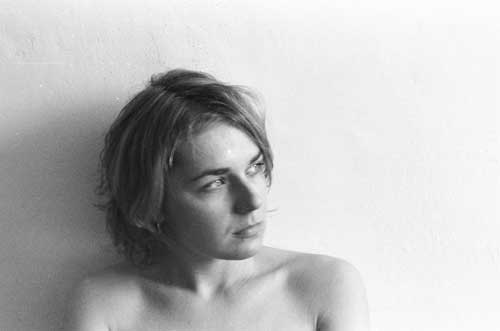
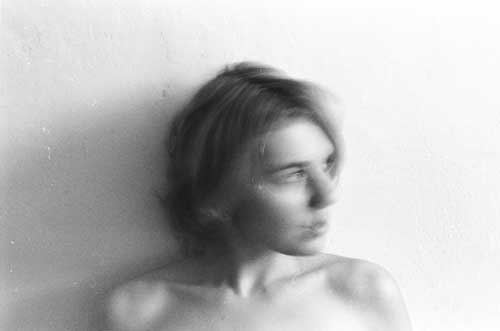
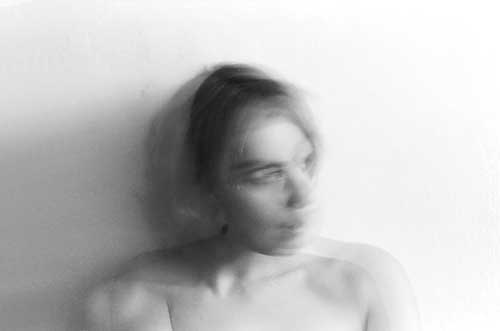


Switch III, 2004/2005

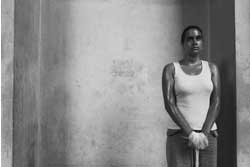
Dysfunction, 2005
Copyright ©2006 Galeria FF ŁDK, Magda Hueckel, Agata Serafin, Krzysztof Jurecki.